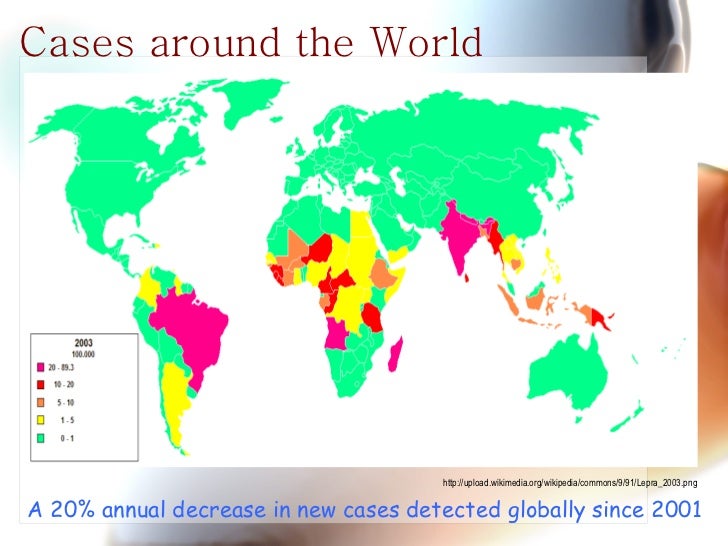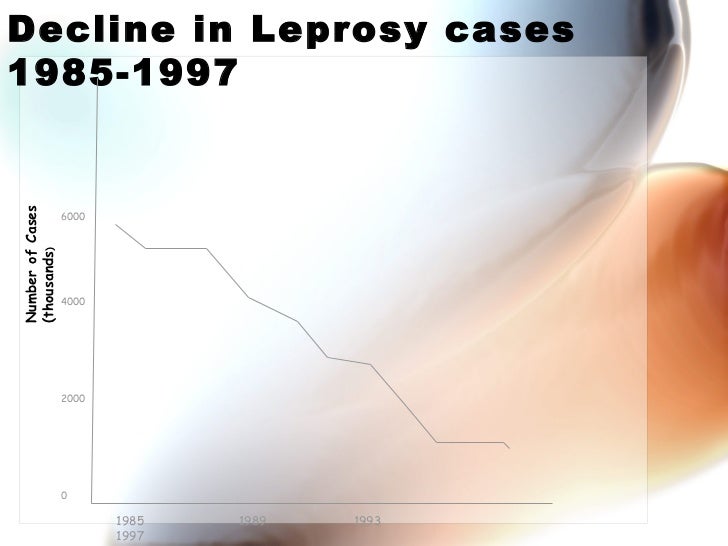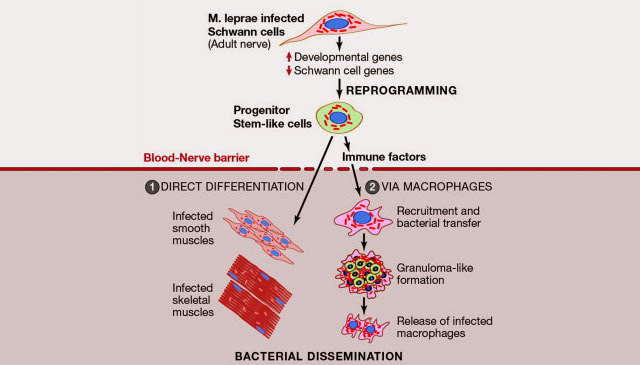INTRODUCTION :
Leprosy is a granulomatous infectious disease caused by Mycobacterium leprae.Leprosy is most commonly found in the developing world in developed countries, most cases are found among immigrants.The World Health Organization reported a global registered leprosy prevalence of 212,802 at the start of 2008.M.leprae is slow to proliferate and there may be a several year latency between the initial infection and apparent disease.It is probably spread through respiratory secretions, though most of the population is not susceptible to leprosy.


DEFINITION :
Leprosy also called Hansen's Disease , is a chronic infectious disease that primarily affects the skin , the peripheral nerves , the mucosa of the upper respiratory tract and the eyes. Leprosy can lead to progressive permanent damage of these structures and resulting devasting disfigurement and disability has led to the historical social stigma and isolation (leper colonies) of those affected by the disease.
INCIDENCE :


Every year between two and three hundred thousand people are diagnosed with it and an estimated two to three million people around the world are disabled because of it. Leprosy is a mildly infectious disease caused by a bacillus called Mycobacterium leprae (a relative of TB).
HOW IS LEPROSY SPREAD ?
Leprosy is spread through contact with mucous of infected person, usually when he or she sneezes or coughs. The disease is not highly contagious. Close, frequent contact with an untreated person is required to contract leprosy. The bacteria responsible for leprosy multiply very slowly.
ETIOLOGY :
- Leprosy is caused by a slow-growing type of bacteria called Mycobacterium leprae (M. leprae). Leprosy is also known as Hansen's disease, after the scientist who discovered M.leprae in 1873.
- Leprosy is caused mainly by Mycobacterium leprae, a rod-shaped bacillus that is an obligate intracellular (only grows inside of certain human and animal cells) bacterium.
- M. leprae is termed an "acid fast" bacterium because of its chemical characteristics.
RISK FACTORS :
- People at highest risk are those who live in the areas where leprosy is endemic (parts of India, China, Japan, Nepal, Egypt, and other areas) and especially those people in constant physical contact with infected people.
- There is some evidence that genetic defects in the immune system may cause certain people to be more likely to become infected (region q25 on chromosome 6).
- People who handle certain animals that are known to carry the bacteria (for example, armadillos, African chimpanzee, sooty mangabey, and cynomolgus macaque) are at risk of getting the bacteria from the animals, especially if they do not wear gloves while handling the animals.
PATHOPHYSIOLOGY :

TYPES :
WHO categorizes the disease based on the type and number of skin areas
affected. They are:
1. paucibacillary—five or fewer lesions with no bacteria detected in the skin smear (sample taken from the area)
•intermediate leprosy—a few flat lesions that sometimes heal by themselves and can progress to a more severe type.
• tuberculoid leprosy—a few flat lesions, some large and numb; some nerve involvement, can heal on its own, persist, or may progress to a more severe form.
•borderline tuberculoid leprosy—lesions like tuberculoid but small and more numerous; less nerve enlargement, may persist, revert to tuberculoid, or advance to another form.
2. multibacillary—more than five lesions or bacteria is detected in the skin smear, or both.
• mid-borderline leprosy—reddish plaques, moderate numbness, swollen lymph glands; may regress, persist, or progress to other forms.
• borderline lepromatous leprosy—many lesions with flat lesions, raised bumps, plaques, and nodules, sometimes numb; may persist, regress, or progress.
• lepromatous leprosy—many lesions with bacteria; hair loss; nerve involvement; limb weakness , disfigurement , does not regress.
affected. They are:
1. paucibacillary—five or fewer lesions with no bacteria detected in the skin smear (sample taken from the area)
•intermediate leprosy—a few flat lesions that sometimes heal by themselves and can progress to a more severe type.
•borderline tuberculoid leprosy—lesions like tuberculoid but small and more numerous; less nerve enlargement, may persist, revert to tuberculoid, or advance to another form.
2. multibacillary—more than five lesions or bacteria is detected in the skin smear, or both.
• mid-borderline leprosy—reddish plaques, moderate numbness, swollen lymph glands; may regress, persist, or progress to other forms.
• borderline lepromatous leprosy—many lesions with flat lesions, raised bumps, plaques, and nodules, sometimes numb; may persist, regress, or progress.
• lepromatous leprosy—many lesions with bacteria; hair loss; nerve involvement; limb weakness , disfigurement , does not regress.
CLINICAL MANIFESTATIONS :
Painless skin patch accompanied by loss of sensation but not itchiness (Loss of sensation is
a feature of tuberculoid leprosy, unlike lepromatous leprosy, in which sensation is
preserved.)
.jpg) |
| Chronic insensate patch due to leprosy infection. Ho Chi Minh City, Vietnam. (Courtesy of D. Scott Smith, MD) |
- Loss of sensation or paresthesias where the affected peripheral nerves are distributed.
- Wasting and muscle weakness.
- Foot drop or clawed hands (may result from neuritic pain and rapid peripheral nerve damage; as seen in the image below)
.jpg) | ||||
- Ulcerations on hands or feet.
- Lagophthalmos, iridocyclitis, corneal ulceration, and/or secondary cataract due to nerve damage and direct bacillary skin or eye invasion.
- Sudden onset of skin redness and new lesions.
- Erythem nodosum leprosum [ENL]; as seen in the image below).
 |
| Patient with erythema nodosum leprosum type 2 reaction several weeks after initiation of drug therapy. This photograph was taken after tendon release. Redwood City, California. (Courtesy of D. Scott Smith, MD) |
It usually takes about 3 to 5 years for symptoms to appear after coming into contact with the leprosy-causing bacteria.
Some people do not develop symptoms until 20 years later. The time between contact with the bacteria and the appearance of symptoms is called the incubation period. Leprosy's long incubation period makes it very difficult for doctors to determine when and where a person with leprosy got infected.
EXAMINATIONS :
Dapsone
Indication : Primary treatment for dermatitis herpetiformis. It is an antibacterial drug for susceptible cases of leprosy.
Dosage : 25mg and 100mg for oral use (tablet).
Side effect : Liver problem or fetal blood.
Special precaution : G6PD , severe heart disease , liver disease , severe lung disease and serious infections.
Contraindication : Hypersensitivity and pregnancy.
PROGNOSIS :
The prognosis of leprosy varies with the stage of the disease when first diagnosed and treated. For example, early diagnosis and treatment limits or prevents tissue damage so the person has a good outcome. However, if the patient's disease has progressed to more advanced disease, the complications listed below can markedly affect the patient's lifestyle, and thus the condition has a fair to poor prognosis.
EXAMINATIONS :
Physical examination should include the following:
- Evaluation of skin lesions.
- Careful sensory and motor examination.
- Palpation of peripheral nerves for pain or enlargement, with particular attention paid to the following locations:
- Elbows - Ulnar nerve.
- Wrist - Superficial radial cutaneous and median nerves.
- Popliteal fossa - Common peroneal nerve.
- Neck - Great auricular nerve.
4. Skin smears or biopsy -material that show acid-fast bacilli with the Ziehl-Neelsen stain or the Fite stain (biopsy) can diagnose multibacillary leprosy, or if bacteria are absent, diagnose paucibacillary leprosy.
5. Other tests can be done, but most of these are done by specialized labs and may help a clinician to place the patient in the more detailed Ridley-Jopling classification and are not routinely done (lepromin test, phenolic glycolipid-1 test, PCR, lymphocyte migration inhibition test or LMIT).
6. CBC test, liver function tests, creatinine test, or a nerve biopsy may be done to help determine if other organ systems have been affected.
TREATMENT :
1.Systemic antibiotic therapy to prevent deep infection.
2.Topical antibacterial therapy ex: mupirocin..the medication must be applied to the lession several times daily for week.
Mupirocin ( Muprin)
Indication : Bacterial skin infections.
Dosage : Adult and children apply one TDS for up to ten days.
Special precaution : Not for ophth or intranasal use. Avoid contact with eyes. Moderate to severe renal impairment.
Side effect : Burning , stinging and itching of the skin.
1.Systemic antibiotic therapy to prevent deep infection.
2.Topical antibacterial therapy ex: mupirocin..the medication must be applied to the lession several times daily for week.
Mupirocin ( Muprin)
Indication : Bacterial skin infections.
Dosage : Adult and children apply one TDS for up to ten days.
Special precaution : Not for ophth or intranasal use. Avoid contact with eyes. Moderate to severe renal impairment.
Side effect : Burning , stinging and itching of the skin.
3.Multidrug therapy is the accepted method as it cures
patients, reduces the reservoir of infection and interrupts transmission. It
also prevents disability as patients are cured before the disease progresses. Leprosy is divided into two types for treatment
(World Heath Organization, 2005):
- - Paucibacillary, involving one to five skin lesions. Rifampicin and dapsone are given for six months.
Rimactane ( Rifampicin)
Indication : Combination with other antibiotic /
chemotheraphy agents in all forms of Tb and Leprosy .
Dosage : 450mg to 600mg per day (adult).
10-20 mg / kg per day . maximum 600mg per day
(children) .
Side effect : Reddish brown discolouration of body
fluid , gastrointestinal disturbance , hepatic toxicity and renal failure .
Contraindication : hypersensitivity , jaundice .
Special precaution : Liver disease , pregnancy ,
premature and newborn infant.
- - Multibacillary, involving more than five skin lesions. Rifampicin, clofazimine and dapsone are given for 12 months.
Dapsone
Indication : Primary treatment for dermatitis herpetiformis. It is an antibacterial drug for susceptible cases of leprosy.
Dosage : 25mg and 100mg for oral use (tablet).
Side effect : Liver problem or fetal blood.
Special precaution : G6PD , severe heart disease , liver disease , severe lung disease and serious infections.
Contraindication : Hypersensitivity and pregnancy.
PROGNOSIS :
The prognosis of leprosy varies with the stage of the disease when first diagnosed and treated. For example, early diagnosis and treatment limits or prevents tissue damage so the person has a good outcome. However, if the patient's disease has progressed to more advanced disease, the complications listed below can markedly affect the patient's lifestyle, and thus the condition has a fair to poor prognosis.
PREVENTION :
Prevention of contact with droplets from nasal and other secretions from patient with untreated M.Leprae infection currently is a a way recommended to avoid the disease.
COMPLICATIONS :
In addition, the sensory loss causes people to injure body parts without the individual being aware that there is an injury; this can lead to additional problems such as infections and poor wound healing.
1. Impaired skin intergrity related to disease process.
2. Disturbed
body image related to disease process.
VIDEO :
COMPLICATIONS :
The complications of leprosy depend on how quickly the disease is diagnosed and effectively treated.
- Permanent nerve damage (usually in extremities).
- Muscle weakness.
- Progressive disfigurement (for example, eyebrows lost, disfigurement of the toes, fingers, and nose).
In addition, the sensory loss causes people to injure body parts without the individual being aware that there is an injury; this can lead to additional problems such as infections and poor wound healing.
NURSING CARE :
1. Impaired skin intergrity related to disease process.
Goal : patient will exhibit improved or healed
lesions or wounds.
Nursing Interventions :
- Inspect patient’s skin every 8 hours, describe and document skin condition and report changes to provide evidence of thr effectiveness of skin care regimen.
- Provide supportive measures as include :
- -Assist with general hygiene and comfort measures to promote comfort and general sense of well being.
- Encourage patient to express his feeling about their skin condition to enhance coping.
Goal : Patient express positive feelings about self.
Nursing Intervention:
- Encourage patient to participate in self-care and and as appropriate to reduce their concern about body image.
- Help patient to identify positive aspect of their appearance to improve self-esteem.
- Encourage patient to participate in a support group with other patient who have been diagnosed witn the same diagnosed with them to express feeling and obtain support who can understand their concerns.
3.Anxiety
related to disease process.
Goal : Patient is able to be calm and peaceful.
Nursing Intervention:
- Teach client regarding disease process to reduce their anxiety.
- Explain the care and ask them question to measure patient level of understanding.
- Introduce the client to hospital environment to comfort the patient.
CONCLUSION :
Leprosy is a horrible disease. It is disheartening to know that even in this day and age people diagnosed with this disease are still frowned upon and shunned from their communities. Maybe one day this will be a disease that no longer exists only mentioned in medical history book.
REFERENCE :
- Sheila S.S & Cynthia M.T (2009) Nursing Diagnosis Reference Manual , Ed 9th , Philadelphia : Lippincort Williams & wilkins.
- http://www.nlm.nih.gov/medlineplus/ency/article/001347.htm
- http://www.webmd.com/skin-problems-and-treatments/guide/leprosy-symptoms-treatments-history?page=2
- http://www.slideshare.net/yousrydermatology/my-lecture-on-atopy

.jpg)

.jpg)

.jpg)
.jpg)

As a sign of gratitude of how i was saved from syphilis, i decided to reach out to those still suffering from this.i suffered syphilis in the year 2013 and it was really tough and heartbreaking for me because the symptoms were terrible, i always have vaginal discharge, and body itching . we tried various therapies prescribed by our neurologist but none could cure me. I searched for a cure and i saw a testimony by someone who was cured and so many other with similar body problem, and he left the contact of the doctor who had the cure to syphilis . I never imagined syphilis . has a natural cure not until i contacted him and he assured me that i will be fine. I got the herbal medication he recommended and i used it and in one months time i was fully okay even up till this moment am so full of life.syphilis . has a cure and it is a herbal cure contact the doctor for more info on drwilliams098675@gmail.com on how to get the medication. Thanks for reading my testimony
ReplyDelete
ReplyDeleteI am so happy how Dr Voke cured me from Herpes virus and Hepatitis-b, since 4 year ago i was effected with herpes simplex virus 1 and hepatitis-b, and i have taken all manner of drugs prescribed to me by several doctors,but all my effort was wasted,i cried all day thinking on how i can be cured of this illness, i lost hope while i was looking for solution for my health,but one faithful day, i was searching the internet i came across several testimonies about Dr Voke, and how he has cure so many effected individual ,so i try and contact his email and asked him for solution about my herpes simplex virus 1 and he started the preparation to my cure,to my greatest surprise after two weeks, i was totally cure by his powerful herbal medicine,i never believe that i could be cured from this wicked disease until i met Dr voke i’m very grateful to you and i know your herbal medicine will save more millions of lives. his email Address: doctorvoke@yahoo.com,
connect with him on facebook
https://www.facebook.com/Drvoke/